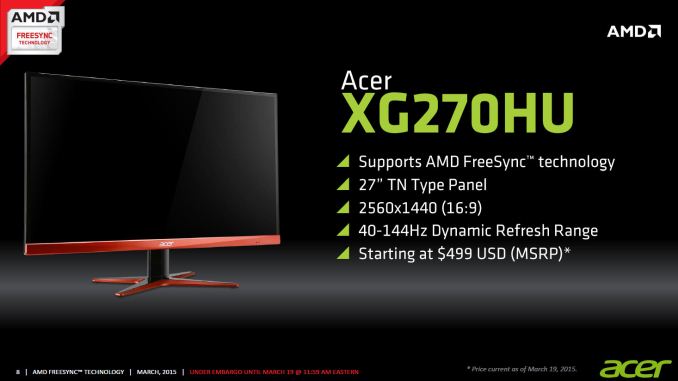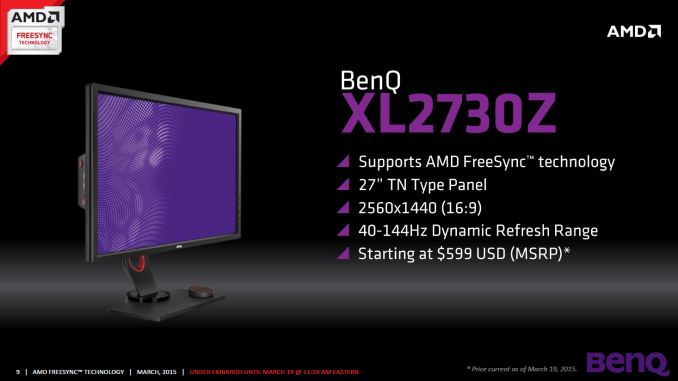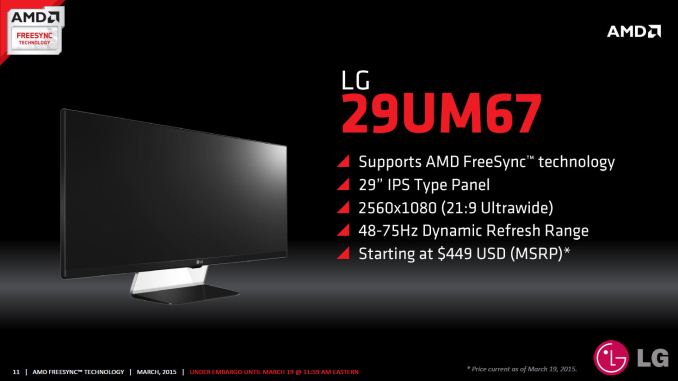The AMD FreeSync Review
by Jarred Walton on March 19, 2015 12:00 PM ESTFreeSync Displays
There are four FreeSync displays launching today, one each from Acer and BenQ, and two from LG. Besides the displays launching today, seven additional displays should show up in the coming weeks (months?). Here’s the current list of FreeSync compatible displays, with pricing where it has been disclosed.
| FreeSync Compatible Displays | ||||||
| Manufacturer | Model | Diagonal | Resolution | Refresh | Panel | Price |
| Acer | XG270HU | 27" | 2560x1440 | 40-144Hz | TN | $499 |
| BenQ | XL2730Z | 27" | 2560x1440 | 40-144Hz | TN | $599 |
| LG Electronics | 34UM67 | 34" | 2560x1080 | 48-75Hz | IPS | $649 |
| LG Electronics | 29UM67 | 29" | 2560x1080 | 48-75Hz | IPS | $449 |
| Nixeus | NX-VUE24 | 24" | 1920x1080 | 144Hz | TN | ? |
| Samsung | UE590 | 28" | 3840x2160 | 60Hz | TN | ? |
| Samsung | UE590 | 23.6" | 3840x2160 | 60Hz | TN | ? |
| Samsung | UE850 | 31.5" | 3840x2160 | 60Hz | TN? | ? |
| Samsung | UE850 | 28" | 3840x2160 | 60Hz | TN? | ? |
| Samsung | UE850 | 23.6" | 3840x2160 | 60Hz | TN? | ? |
| Viewsonic | VX2701mh | 27" | 1920x1080 | 144Hz | TN | ? |
The four displays launching today cover two primary options. For those that want higher refresh rates, Acer and BenQ have TN-based 40-144Hz displays. Both are 27” WQHD displays, so it’s quite probable that they’re using the same panel, perhaps even the same panel that we’ve seen in the ASUS ROG Swift. The two LG displays meanwhile venture out into new territory as far as adaptive refresh rates are concerned. LG has both a smaller 29” and a larger 34” 2560x1080 (UW-UXGA) display, and both sport IPS panels (technically AU Optronics' AHVA, but it's basically the same as IPS).
The other upcoming displays all appear to be using TN panels, though it's possible Samsung might offer PLS. The UE590 appears to be TN for certain, with 170/160 degree viewing angles according to DigitalTrends. The UE850 on the other hand is targeted more at imaging professionals, so PLS might be present; we'll update if we can get any confirmation of panel type.
One of the big benefits with FreeSync is going to be support for multiple video inputs – the G-SYNC displays so far are all limited to a single DisplayPort connection. The LG displays come with DisplayPort, HDMI, and DVI-D inputs (along with audio in/out), and the Acer is similarly equipped. Neither one has any USB ports, though the BenQ does have a built-in USB hub with ports on the side.
Our testing was conducted on the 34UM67, and let me just say that it’s quite the sight sitting on my desk. I’ve been bouncing between the ASUS ROG Swift and Acer XB280HK for the past several months, and both displays have their pros and cons. I like the high resolution of the Acer at times, but I have to admit that my aging eyes often struggle when running it at 4K and I have to resort to DPI scaling (which introduces other problems). The ASUS on the other hand is great with its high refresh rates, and the resolution is more readable without scaling. The big problem with both displays is that they’re TN panels, and having come from using a 30” IPS display for the past eight years that’s a pretty painful compromise.
Plopping the relatively gigantic 34UM67 on my desk is in many ways like seeing a good friend again after a long hiatus. “Dear IPS (AHVA), I’ve missed having you on my desktop. Please don’t leave me again!” For the old and decrepit folks like me, dropping to 2560x1080 on a 34” display also means reading text at 100% zoom is not a problem. But when you’re only a couple feet away, the relatively low DPI does make the pixels much more visible to the naked eye. It even has built-in speakers (though they’re not going to compete with any standalone speakers in terms of audio quality).
The launch price of $649 is pretty impressive; we’ve looked at a few other 21:9 displays in the past, and while the resolution doesn’t match LG’s 34UM95, the price is actually $50 less than the LG 34UM65’s original $699 MSRP (though it’s now being sold at $599). So at most, it looks like putting in the new technology to make a FreeSync display costs $50, and probably less than that. Anyway, we’ll have a full review of the LG 34UM67 in the coming weeks, but for now let’s return to the FreeSync discussion.
Pricing vs. G-SYNC
It certainly appears that AMD and their partners are serious about pricing FreeSync aggressively, though there aren’t direct comparisons available for some of the models. The least expensive FreeSync displays start at just $449, which matches the least expensive G-SYNC display (AOC G2460PG) on price but with generally better specs (29” 2560x1080 and IPS at 75Hz vs. 24” 1920x1080 TN at 144Hz). Looking at direct comparisons, the Acer XG270HU and BenQ XL2730Z are WQHD 144Hz panels, which pits them against the $759 ASUS ROG Swift that we recently reviewed, giving FreeSync a $160 to $260 advantage. As AMD puts it, that’s almost enough for another GPU (depending on which Radeon you’re using, of course).
Based on pricing alone, FreeSync looks poised to give G-SYNC some much needed competition. And it’s not just about the price, as there are other advantages to FreeSync that we’ll cover more on the next page. But for a moment let’s focus just on the AMD FreeSync vs. NVIDIA G-SYNC ecosystems.
Right now NVIDIA enjoys a performance advantage over AMD in terms of GPUs, and along with that they currently carry a price premium, particularly at the high end. While the R9 290X and GTX 970 are pretty evenly matched, the GTX 980 tends to lead by a decent amount in most games. Any users willing to spend $200 extra per GPU to buy a GTX 980 instead of an R9 290X might also be willing to pay $200 more for a G-SYNC compatible display. After all, it’s the only game in town for NVIDIA users right now.
AMD and other companies can support FreeSync, but until – unless! – NVIDIA supports the standard, users will be forced to choose between AMD + FreeSync or NVIDIA + G-SYNC. That’s unfortunate for any users that routinely switch between AMD and NVIDIA GPUs, though the number of people outside of hardware reviewers that regularly go back and forth is miniscule. Ideally we’d see one standard win out and the other fade away (i.e. Betamax, HD-DVD, etc.), but with a one year lead and plenty of money invested it’s unlikely NVIDIA will abandon G-SYNC any time soon.
Prices meanwhile are bound to change, as up to now there has been no competition for NVIDIA’s G-SYNC monitors. With FreeSync finally available, we expect prices for G-SYNC displays will start to come down, and in fact we’re already seeing $40-$125 off the original MSRP for most of the G-SYNC displays. Will that be enough to keep NVIDIA’s proprietary G-SYNC technology viable? Most likely, as both FreeSync and G-SYNC are gamer focused more than anything; if a gamer prefers NVIDIA, FreeSync isn’t likely to get them to switch sides. But if you don’t have any GPU preference, you’re in the market for a new gaming PC, and you’re planning on buying a new monitor to go with it, R9 290X + FreeSync could save a couple hundred dollars compared to GTX 970 + G-SYNC.
There's something else to consider with the above list of monitors as well: four currently shipping FreeSync displays exist on the official day of launch, and Samsung alone has five more FreeSync displays scheduled for release in the near future. Eleven FreeSync displays in the near term might not seem like a huge deal, but compare that with G-SYNC: even with a one year lead (more or less), NVIDIA currently only lists six displays with G-SYNC support, and the upcoming Acer XB270HU makes for seven. AMD also claims there will be 20 FreeSync compatible displays shipping by the end of the year. In terms of numbers, then, DP Adaptive Sync (and by extension FreeSync) look to be winning this war.


























350 Comments
View All Comments
imaheadcase - Thursday, March 19, 2015 - link
The cost means nothing, keep in mind the people buying this stuff pay out the nose already for hardware. Given that most people who by nvidia cards are going to get a Gsync, cost has no meaning.This is a double bad thing for AMD..first its still tied to IT'S graphics card (NV already so no to support), and 2nd the monitors announced already are already below the specs Freesync is suppose to do, and worse than next gen Gsync monitors.
I mean i love competition like the next person, but this is just PR making it seem like its a good thing when its not.
SleepyFE - Thursday, March 19, 2015 - link
Your name says it all. Do you really think manufacturers will beg NVidia to come and mess with their manufacturing process just to include something that only they support? Time will come when phone makers will join and they mostly don't use NVidia GPU's. So now you have NVidia vs AMD and Intel (for ultrabooks) and ARM (Mali) and PowerVR. You think NVidia can hold them off with overpricing and PR?Murloc - Thursday, March 19, 2015 - link
uhm no?I'd want my next monitor to be GPU agnostic ideally.
And I'd want to use an nvidia card with it because right now AMD cards are still ovens compared to nvidia.
Not because I like paying through the nose, a 750 Ti doesn't cost much at all.
I'll hold out since I'm trusting that this thing will solve itself (in favour of the industry standard, adaptive sync) sooner or later.
Ranger101 - Friday, March 20, 2015 - link
So a difference of 10 degrees celsius under load makes an AMD gpu an OVEN and an Nvidia gpu presumably a Fridge by comparison....LOL.Lakku - Wednesday, May 6, 2015 - link
The reported GPU temp means nothing. That is just an indication of the heatsink/fans ability to remove heat from the GPU. You need to look at power draw. The AMD GPUs draw significantly more power than current nVidia cards for less performance. That power generates heat, heat that needs to go somewhere. So while the AMD cards may be 10 degrees Celsius more, which isn't minimal in and of itself, it is having to dissipate quite a bit more generated heat. The end result is AMD GPUs are putting out quite a bit more heat than nVidia GPUs.althaz - Thursday, March 19, 2015 - link
There are a bunch of 4k monitors announced. Yet there are no 4k G-Sync monitors available - how is that worse specs?I'd buy a 4k 27" G-Sync display at a reasonable price in a heartbeat. In fact I'd buy two.
thejshep - Thursday, March 19, 2015 - link
Acer XB280HK http://www.newegg.com/Product/Product.aspx?Item=N8...arneberg - Thursday, March 19, 2015 - link
Freesync today are only open to people with radeon cards. AMD made the better deal they let the monitor builders take the cost for freesync. Nvidia made the hardware themselfchizow - Thursday, March 19, 2015 - link
Huh? Who cares if its open/closed/upside down/inside out? G-Sync is better because it is BETTER at what it set out to do. If it is the better overall solution, as we have seen today it is, then it can and should command a premium. This will just be another bulletpoint pro/con for Nvidia vs. AMD. You want better, you have to pay for it, simple as that.lordken - Thursday, March 19, 2015 - link
better? did we read same article? I cant find where it says that gsync is better than freesync. In what aspect it is better?And answer for your 1st question is, anyone with the brain. Thing is that nvidia could enable support for freesync if it wouldnt hurt their pride, which would be big benefit for their customers (you wouldnt be restricted on monitor selection) but they chose what is better for them, pushing gsync & milking more money from you.
This is pretty stupid, while you may be some average gamer that thinks it is fine to have your monitor selection restricted to 2% normal people probably wouldnt be that happy. The way it should be is that every monitor should support freesync (or whatever you call it) as this is display feature and should have been in 1st place developed by LCD makers but they dont give a shit to provide excellent displays as far as they can sell shit that people are buying like crazy (not refering to gsync monitors now).
Vendor lockin is always a bad thing.
Oh and article says that gsync monitor doesnt provide advanced OSD as comon panels today...so yeah gsync is clearly better